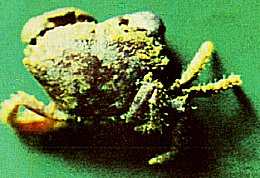 Synonyms: Pilumnus
hirtellus Czerniavsky 1884; Cancer hirtellus (L. 1766)
Synonyms: Pilumnus
hirtellus Czerniavsky 1884; Cancer hirtellus (L. 1766)Pilumnus hirtellus Linnaeus, 1758
 Synonyms: Pilumnus
hirtellus Czerniavsky 1884; Cancer hirtellus (L. 1766)
Synonyms: Pilumnus
hirtellus Czerniavsky 1884; Cancer hirtellus (L. 1766)
Common names: Engl: Mud crab; Rom: Crabul paros; Russ: Volosaty krab; Turk: Camur yengeci; Ukr: Volokhaty krab
Order: DECAPODA
Family: XANTHIDAE
Taxonomic descriptions: Small-size crab, very hairy. Anterolateral side shorter than posteriolateral side. Front with an obvious median split and two lateral smaller each of them with a preorbital spine; both lobs delimited, toothed. Superior margin of the orbit without spine, the inferior and both edges with spine. Anterolateral edge with 4 big spines. Unequal chela; the right chela is stronger. Merus short. Carpus hirsute with tubercles and a big interdistal spine. Hairy species with spines all over the body and palm.The nude fingers with tubercles teeth. Pereiopods II-V without spine. The other pereiopods very hairy with long, conical dactylus with terminal craws. Size: length - 20 mm; width - 28 mm. Color: carapace and superior side of pereiopods reddish - violet. Fingers of chela brown. Inferior part of pereiopods ivory. The young less than 5 mm completely white, like chalk, especially in winter.
 IUCN Status:
IUCN Status:
World level:
Black Sea Regional level:
Subregion level: VU
Distribution:
Habitat type, Critical habitats, Limiting factors: In meddlittoral and superior infralittoral on different substrata; favourite biotop being stony grounds with alga and mussels at depth of 0-10m .Throughout the Mediterranean Sea and the eastern Atlantic Ocean from the North Sea to Cape Verde Islands. Hard frost, storms and pollution in the coastal zone.
Biology: Sedentary species; spawns up to 4 thousand eggs; planktonic larvae: stadies of zoe and megalope; eats corpses and even shells.
Population trends: On the Romanian Black Sea littoral abundant in the past, still frequent up to 1980; a small number of individuals were found on the southern littoral zone in the period 1980-1993 (in 1993 - 40 ind/m2 in superior infralittoral Eforie North - Mangalia zone).
Threats: Coastal terrigenous pollution by hydrotechnical works.
Conservation measures taken: Included in the Red Data Book of Ukraine, 1994.
Conservation measures proposed: Artificial reefs to increase biofiltration and reduce turbidity.
References:
Compiled by: C.Dumitrache